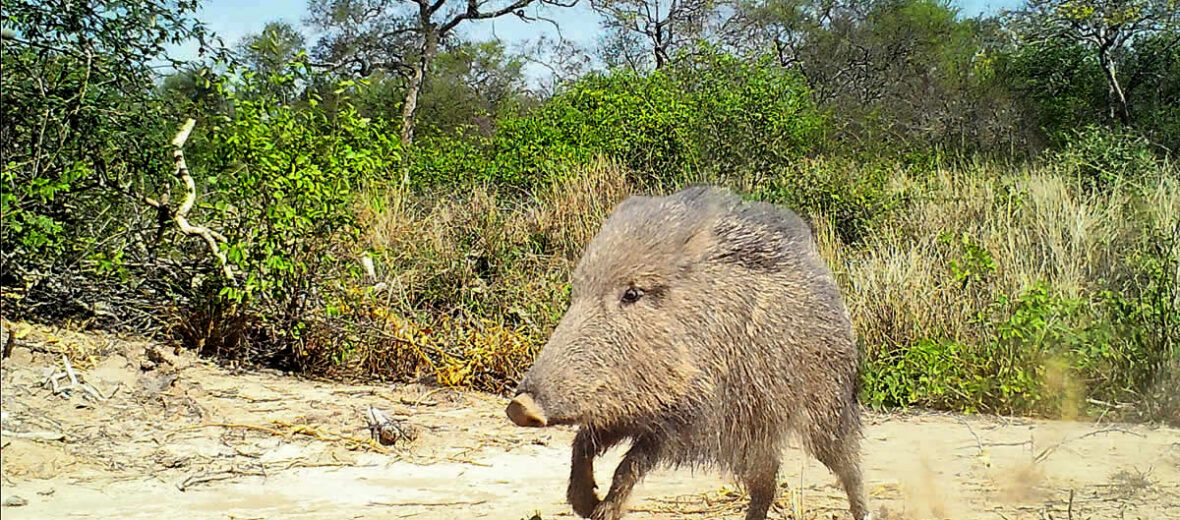
The Chacoan peccary, aka tagua, can be found in Argentina, Bolivia, and the Gran Chaco of Paraguay. They are the only extant species of the genus Catagonus. Sadly, these critters face the threats of habitat loss and destruction at the hands of farming, ranching, and dams; hunting; trapping; and invasive species, which can cause diseases and compete with them for food. The IUCN lists these peccaries as Endangered. Their global numbers of an estimated 3,000- are also decreasing.
First the Stats…
Scientific name: Catagonus wagneri or Parachoerus wagneri
Weight: Up to 88 lbs.
Length: Up to 46 inches
Height: Up to 27 inches, at the shoulders
Lifespan: Up to 18 years
Now on to the Facts!
1.) Chacoan peccaries were first discovered in 1930, based off of bones found. They were, at that time thought to be extinct.
2.) In 1971, a specimen was discovered, alive, in the Chaco region, in the Argentine province of Salta. In 1972 they were officially described.
3.) They prefer hot, dry areas, with a predominant amount of low-lying succulents and thorny bushes, with a smattering of trees.
4.) These critters have well-developed sinuses to fight dry, dusty conditions. Their feet have also evolved to be small, which allows for easier maneuverability among the abundance of spiny plants.
5.) The Chacoan peccary is different from other peccaries in that they have longer ears, snouts, and tails.
But wait, there’s more on the Chacoan peccary!
6.) They have a 3rd hind toe, but other peccaries only have 2 toes.
7.) While births usually happen from September – December, they tend to breed whenever there are bouts of heavy rainfall.
Did you know…?
Chacoan peccaries are the largest of the 3 known peccary species.
8.) Females undergo up to a 152 day gestation that yields up to 4 young.
9.) They are also sometimes called báquiro, javelina, saíno, or taitetu.
10.) These peccaries are diurnal (active during the day).
But wait, there’s still more on the Chacoan peccary!
11.) Peccaries typically travel in herds of up to 20 individuals.
12.) Communication is mostly vocal, via teeth chattering and grunting.
Did you know…?
The Chacoan peccary is capable of producing a milky, smelly substance from a gland in their back that is used for marking trees, shrubs, and rocks.
13.) These peccaries are not as aggressive as other species, but if provoked, they will charge and gore the threat.
14.) They also defecate (poop) at certain “stations” and not just all over.
15.) While primarily eating various species of cacti, they will also gladly consume roots, seed pods, herbs, flowers, and will even eat soil to gain missing minerals.
But wait, there’s still a little more on the Chacoan peccary!
16.) When eating cactuses, they will roll the cacti on the ground to remove spines, and they will also bite off and spit out any additional spines before eating.
17.) These ungulates have a 2-chambered stomach evolved for digesting tough and acidic foods.
Did you know…?
Their bristly coat is interspersed with long guard hairs which may be up to 8.8 inches long.
18.) This species of peccary also looks for salt licks formed from ant mounds.
19.) Breeding populations have been established in North American and European zoos, aimed at keeping the species from going extinct.
20.) Mountain lions and jaguars prey on these critters.
Now a Short Chacoan Peccary Video!
Be sure to share & comment below! Also, check out the Critter Science YouTube channel. Videos added regularly!
Want to suggest a critter for me to write about? Let me know here.
Some source material acquired from: Wikipedia & IUCN
Photo credit: WCS Paraguay



